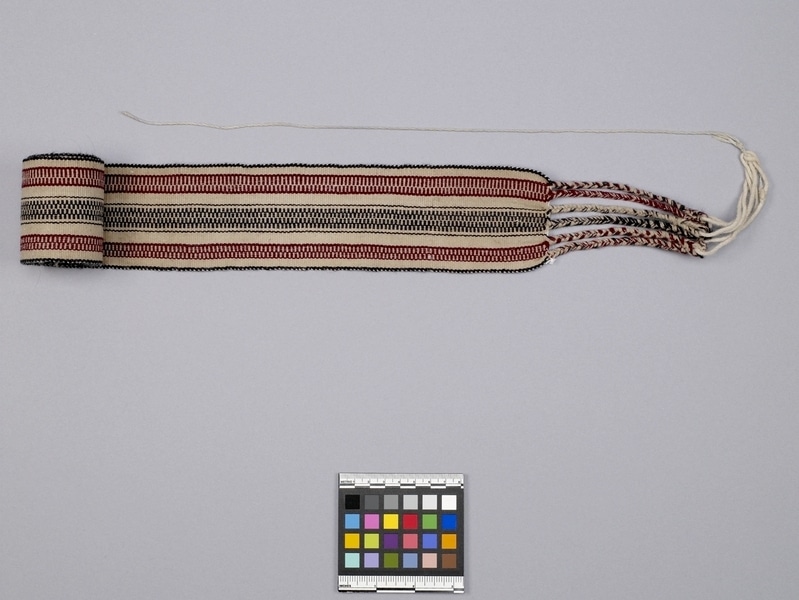Belt Item Number: Sf1007 from the MOA: University of British Columbia


Description
Belt with dark red and black lengthwise stripes on a light grey-brown background. In the centre is a series of black toothed lines flanked by solid black lines. To each side is a smaller series of red toothed lines and along the weft selvedges are solid black lines. One end of the belt is finished withe a fringe of braids, which are joined together by three loops of cord and are then tied to a single cord. Another cord is attached in three places to the selvedge at the other end and a long, single strand of this cord extends as a tie.
History Of Use
Warp-faced fabric with three or four selvedges are woven by women but the fabrics are used by both sexes. The techniques, structures and some of the motifs have pre-Conquest antecedents. This type of textile conveys the most information about an individual's ethnicity, sex, age, status and particular history. Belts with simple stripes and subdued neutral colours are used for infants and young children. These are used in swaddling babies and around the waist of toddlers. When they are slightly older, they switch to the red belts which are typical Taquile style.
Narrative
Bought in the Cooperativo Artesanal Manco Capac in Taquile from Simeon Huatta Cruz, the father-in-law of the maker, Juliana Wille Huatta. He said Juliana made it about a year ago and used it for swaddling her baby. Simeon said that it was best to use black and white on children's belts because red is considered dangerous to the very young.
Iconographic Meaning
The red stripes are called cope and the black stripes, lope, but names are not translatable. The red stripes are also called k'utu (teeth), a reference to the jagged quality of the line.
Specific Techniques
Synthetic commercial yarns, z spun and plied 2 s, a re retwisted before warping; warp-faced plain weave; terminal area braided in 3 strand oblique interlacing. Cords knotted onto belt. One loom piece; uncut.
Cultural Context
swaddling; children
Item History
- Made by Juliana Wille Huatta (Maker) in Taquile, Puno, Peru during 1986
- Collected by Mary Frame during 1987
- Owned by Mary Frame before November 3, 1987
- Received from Mary Frame (Seller) and Museum of Anthropology Shop Volunteers (Funding source) on November 3, 1987
What
- Name
- Belt
- Identification Number
- Sf1007
- Type of Item
- belt
- Material
- synthetic fibre, cotton fibre and dye
- Manufacturing Technique
- retwisted, braided, knotted and woven
- Overall
- height 8.0 cm, width 129.0 cm
Who
- Culture
- Quechua
- Creator
- Juliana Wille Huatta (Maker)
- Field Collector
- Mary Frame
- Previous Owner
- Mary Frame
- Received from
- Mary Frame (Seller) and Museum of Anthropology Shop Volunteers (Funding source)
Where
- Holding Institution
- MOA: University of British Columbia
- Made in
- Taquile, Puno, Peru
When
- Creation Date
- during 1986
- Collection Date
- during 1987
- Ownership Date
- before November 3, 1987
- Acquisition Date
- on November 3, 1987
Other
- Item Classes
- textiles
- Condition
- good
- Accession Number
- 1274/0007